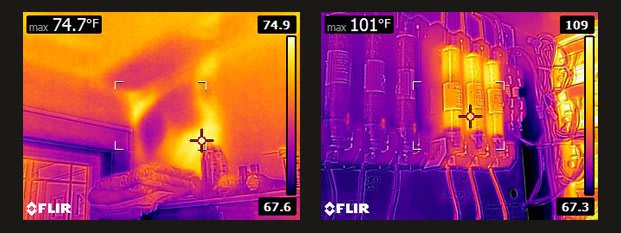Key Differences
- Non-radiometric Spot IR Camera
- Max Temperature: 716 F
- Thermal Accuracy: ±1.5°C or 1.5%
- Field of View: 50° x 38.6°
- Screen Size: 2-inch
- MSX Technology: No
- Ingress Protection: N/A
- Wi-Fi Connectivity: No
- Radiometric Fully-Featured IR Camera
- Max Temperature: 482 F
- Thermal Accuracy: ±2°C or 2%
- Field of View: 45° x 34°
- Screen Size: 3-inch
- MSX Technology: Yes
- Ingress Protection: IP54
- Wi-Fi Connectivity: Yes
Overview
The FLIR TG165 and FLIR E4 are each powerful thermal imaging tools, designed to save you time and money by helping you troubleshoot electrical, mechanical, building, and HVAC applications faster than ever. Each camera lets you “see the heat” so you can detect hidden problems before they become big issues. That said, there are many differences between these infrared cameras.
The primary difference between the two is the applications they were designed for. The E4 is a fully-featured thermal camera designed for professional troubleshooting of building, electrical, and mechanical applications. This camera is at home in demanding industrial applications thanks to its 2-meter drop test and IP54 ratings. Images from the E4 are fully radiometric, meaning you get temperature data for the full scene, not just the center spot. The E4 also has Wi-Fi connectivity so you can easily transfer images to the FLIR Tools App. In the App, you can analyze and edit images before sending out professional reports directly from the App.
Sample Images from the E4 w/ MSX:

The E4 also includes FLIR’s powerful MSX image enhancement technology. MSX adds key details from the onboard visible light camera to the entire infrared image in real time. The resulting thermal picture includes clear visible light features so you can instantly recognize where the problematic heat pattern is. This eliminates the need for a visible light reference image and saves you time during reporting. This technology is not included on the TG165.
The TG165 on the other hand is a spot thermal camera which bridges the gap between single spot IR thermometers and FLIR’s legendary thermal cameras. The infrared images produced by the TG165 are not radiometric, meaning that the thermal heat map is really just for show - the actual displayed temperature reading is taken by a built-in IR thermometer. This makes the TG165 more suited to lighter duty applications like DIY home repair and basic electrical troubleshooting where image reporting is not required.
Sample Images from the TG165:

These cameras are often compared because some of their thermal imaging specifications are similar – for example, both cameras feature 80x60 infrared resolution as well as 150mK thermal sensitivity and a 9Hz frame rate. Both cameras feature a 10-year warranty on the IR detector and a 2-year warranty on the product. The E4 also includes a 5-year warranty on the battery.
In other key areas like temperature measurement range, the TG165 actually wins with -13 to 716°F, compared to -4°F to 482°F on the E4. The TG165 also has ±1.5% or ±1.5°C accuracy, compared to ±2% or ±2°C on the E4. The E4 gains some ground back with a larger 3-inch screen, compared to 2-inch on the TG165.
Conclusion
While some of the specs are similar, these cameras are designed for different applications. The E4 is at home in industrial environments and excels here thanks to its rugged design, MSX technology, Wi-Fi connectivity, fast reporting, and fully radiometric images. This camera can help you find the smallest hidden problems in a complex area.
The TG165 is ideal for more casual users who want a temperature reading and a visual heat map – even though these images are not fully radiometric, the heat map can still help you see if a breaker is hot or locate drafty areas of your home where insulation may be missing. The TG165 is also perfect for car mechanics or anyone doing DIY car repair, but is less suited to demanding industrial applications like factory, plant, or utility inspections.
Want to know more? Check out the tables below or give us a call at 877-571-7901. We’re happy to answer any questions you may have.
Learn More about the FLIR TG165Learn More about the FLIR E4